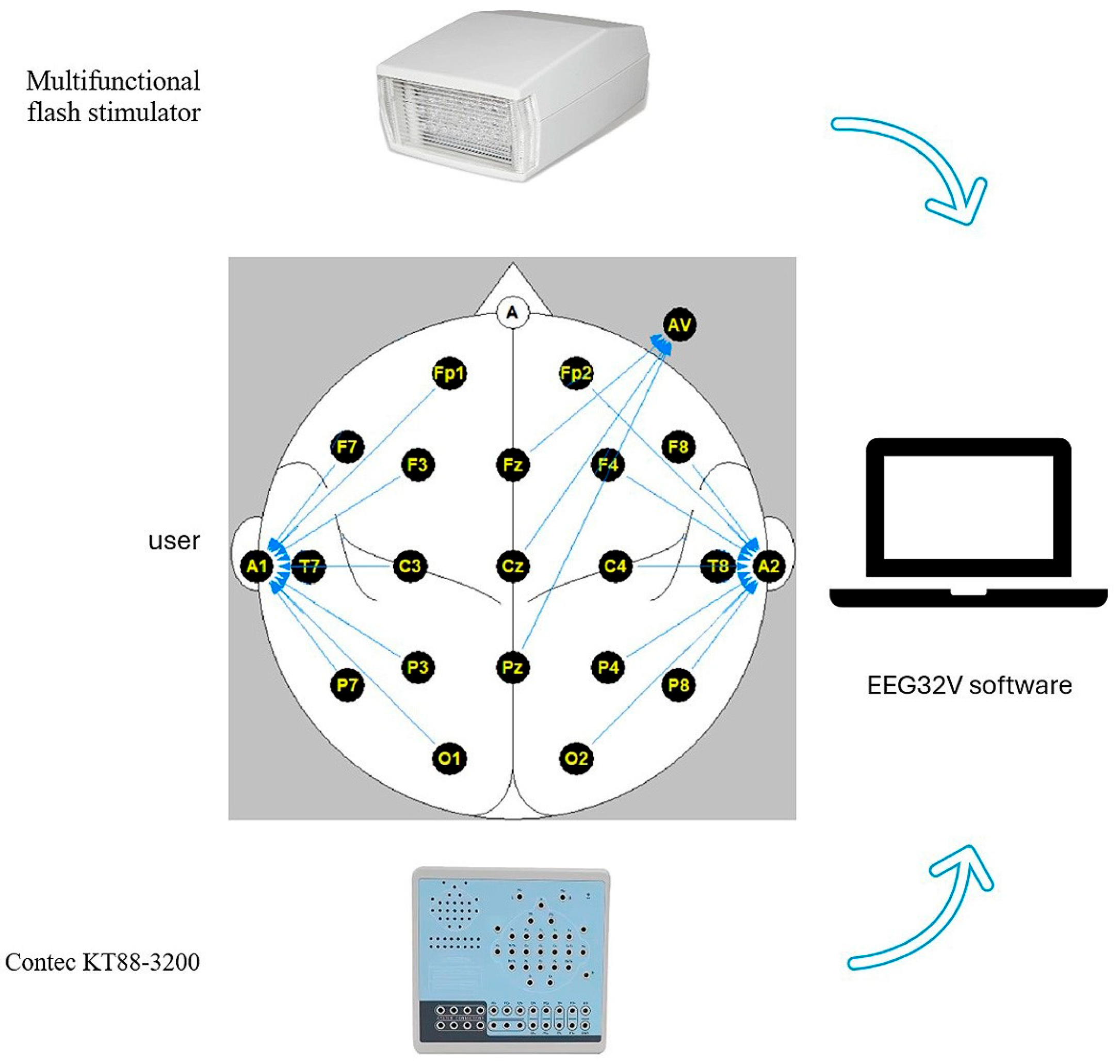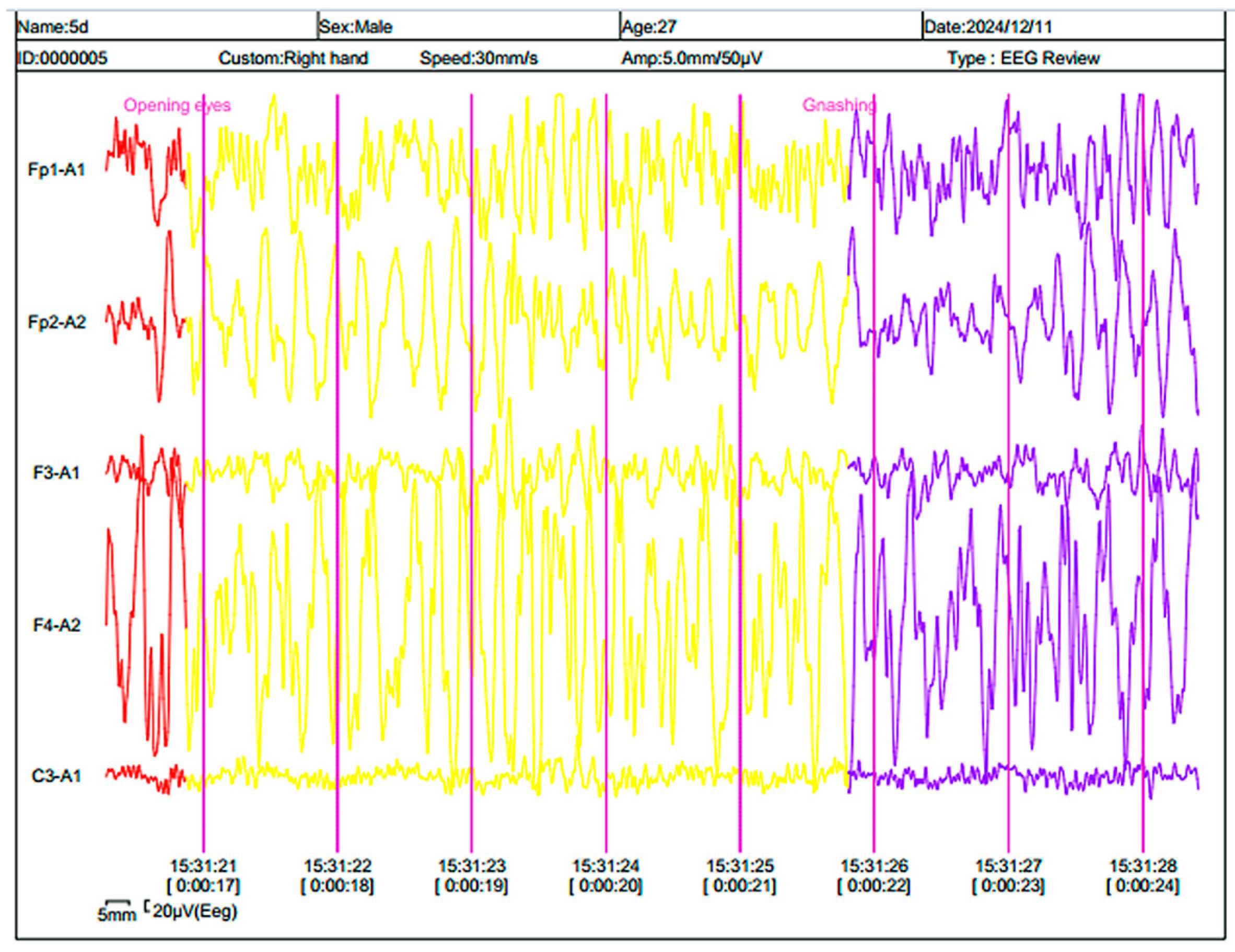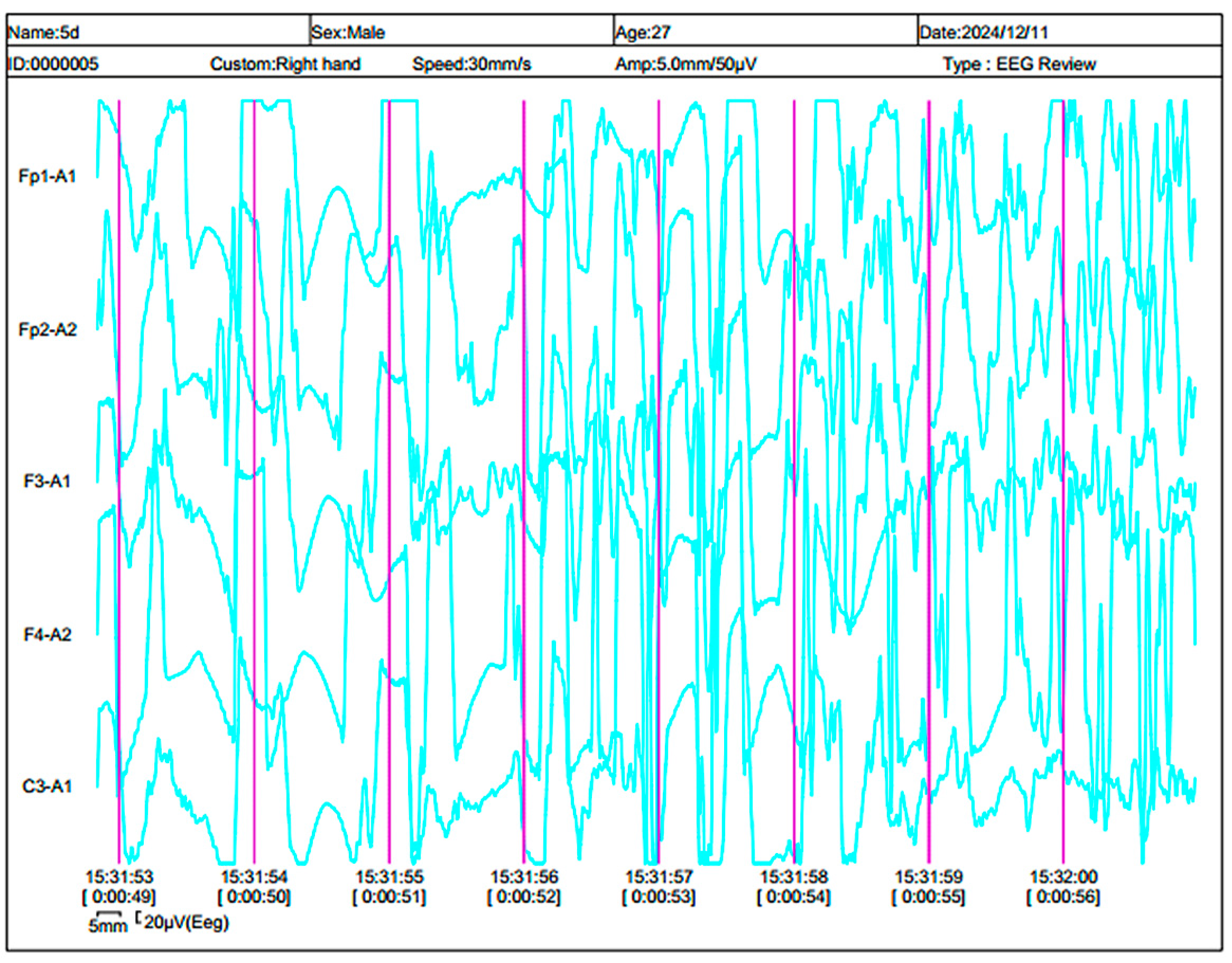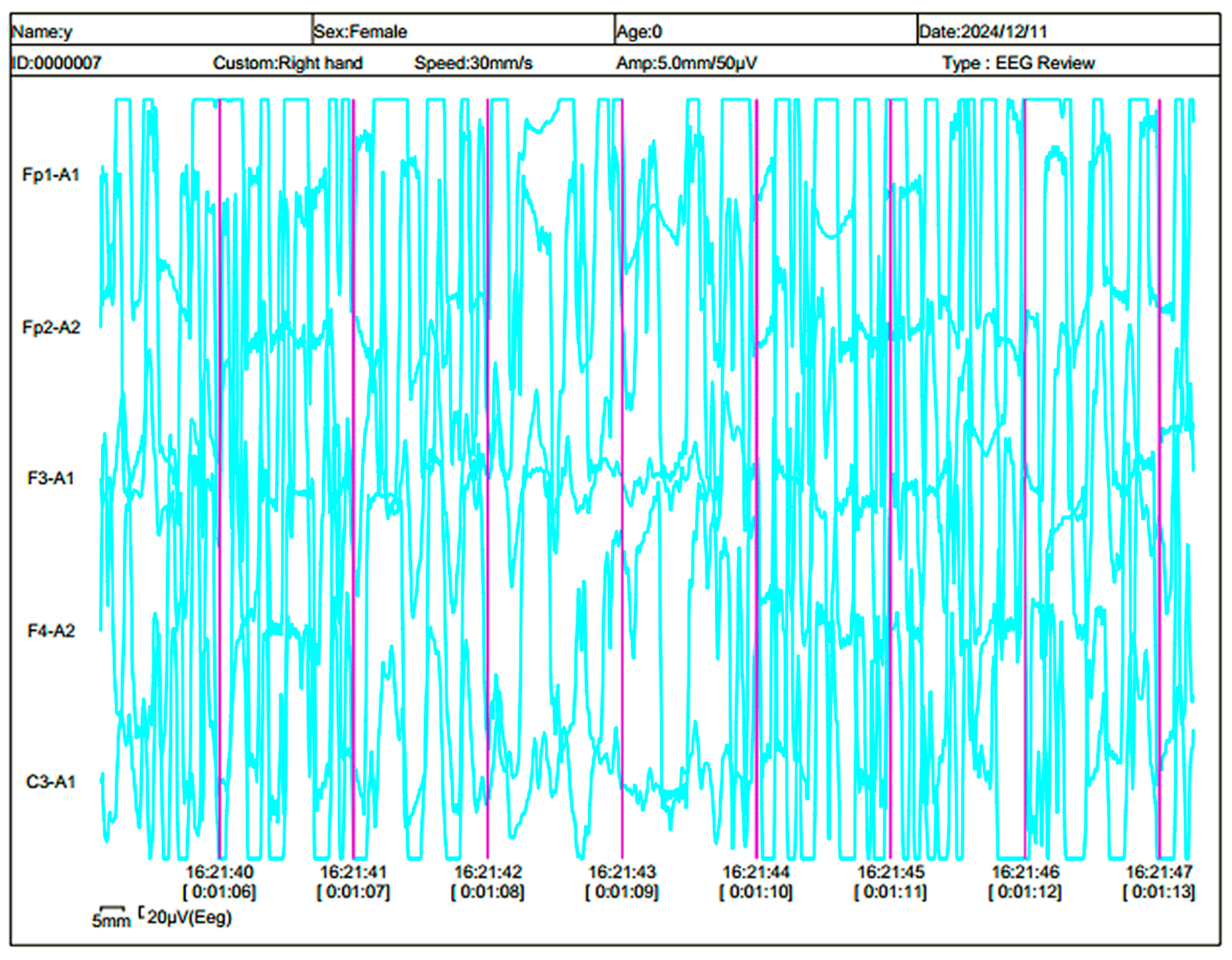Detecting Emotions Using EEG Signals †
Abstract
1. Introduction
2. Digital Electroencephalograph Capabilities for Detecting Emotions
3. Experimental Installation
- The user’s eyes are closed;
- The user is open-eyed;
- A strobing light is turned on, provoking a blinding reaction (photostimulation);
- The condition is observed while performing routine actions.
4. Analysis of the Results Obtained
5. Conclusions
Author Contributions
Funding
Institutional Review Board Statement
Informed Consent Statement
Data Availability Statement
Acknowledgments
Conflicts of Interest
Abbreviations
| EEG | Electroencephalography |
| ECG | Electrocardiography |
| GSR | Galvanic skin response |
| BVP | Blood volume pulse |
| RT | Respiration rate |
| ST | Skin temperature |
| EMG | Electromyography |
References
- Soleymani, M.; Asghari-Esfeden, Y.F.; Pantic, M. Analysis of EEG Signals and Facial Expressions for Continuous Emotion Detection. IEEE Trans. Affect. Comput. 2016, 7, 17–28. [Google Scholar] [CrossRef]
- Rahman, M.; Sarkar, A.K.; Hossain, A.; Hossain, S.; Islam, R.; Hossain, B.; Quinn, J.M.W.; Ali Moni, M. Recognition of human emotions using EEG signals: A review. Comput. Biol. Med. 2021, 136, 104696. [Google Scholar] [CrossRef] [PubMed]
- Zhu, L.; Xu, M.; Huang, A.; Zhang, J.; Tan, X. Multiple class transfer learning framework with source label adaptive correction for EEG emotion recognition. Biomed. Signal Process. Control 2025, 104, 107536. [Google Scholar] [CrossRef]
- Ramirez, R.; Vamvakousis, Z. Detecting Emotion from EEG Signals Using the Emotive Epoc Device. In Brain Informatics. BI 2012. Lecture Notes in Computer Science; Zanzotto, F.M., Tsumoto, S., Taatgen, N., Yao, Y., Eds.; Springer: Berlin/Heidelberg, Germany, 2012; Volume 7670. [Google Scholar] [CrossRef]
- Murugappan, M.; Murugappan, S. Human emotion recognition through short time Electroencephalogram (EEG) signals using Fast Fourier Transform (FFT). In Proceedings of the 2013 IEEE 9th International Colloquium on Signal Processing and Its Applications, Kuala Lumpur, Malaysia, 8–10 March 2013; pp. 289–294. [Google Scholar] [CrossRef]
- Ackermann, P.; Kohlschein, C.; Bitsch, J.Á.; Wehrle, K.; Jeschke, S. EEG-based automatic emotion recognition: Feature extraction, selection and classification methods. In Proceedings of the IEEE 18th International Conference on e-Health Networking, Applications and Services, Healthcom 2016, Munich, Germany, 14–17 September 2016; pp. 1–6. [Google Scholar] [CrossRef]
- Zhetenbayev, N.; Balbayev, G.; Iliev, T.; Bakhtiyar, B. Investigation of a Passive Ankle Joint Exoskeleton Designed for Movements with Dorsal and Plantar Flexion. Eng. Proc. 2023, 41, 17. [Google Scholar] [CrossRef]
- Kumara, N.; Khaunda, K.; Hazarika, S.M. Bispectral Analysis of EEG for E.motion Recognition. Procedia Comput. Sci. 2016, 84, 31–35. [Google Scholar] [CrossRef]
- Morris, H.; Lüders, H. Electrodes. Electroencephalogr. Clin. Neurophysiol. Suppl. 1985, 37, 3–26. [Google Scholar] [PubMed]
- Angeles Castillo Rodriguez, M.; Brandt, A.; Schulze-Bonhage, A. Differentiation of subclinical and clinical electrographic. Epilepsia 2023, 64, S47–S58. [Google Scholar] [CrossRef]
- Macorig, G.; Crespel, A.; Nilo, A.; Phuong Loc Tang, N.; Valente, M.; Gigli, G.L.; Gélisse, P. Benign EEG variants in the sleep—Wake cycle: A prospective observational study using the 10—20 system and additional electrodes. Neurophysiol. Clin. 2021, 51, 233–242. [Google Scholar] [CrossRef] [PubMed]








Disclaimer/Publisher’s Note: The statements, opinions and data contained in all publications are solely those of the individual author(s) and contributor(s) and not of MDPI and/or the editor(s). MDPI and/or the editor(s) disclaim responsibility for any injury to people or property resulting from any ideas, methods, instructions or products referred to in the content. |
© 2025 by the authors. Licensee MDPI, Basel, Switzerland. This article is an open access article distributed under the terms and conditions of the Creative Commons Attribution (CC BY) license (https://creativecommons.org/licenses/by/4.0/).
Share and Cite
Ralev, I.; Krastev, G. Detecting Emotions Using EEG Signals. Eng. Proc. 2025, 104, 13. https://doi.org/10.3390/engproc2025104013
Ralev I, Krastev G. Detecting Emotions Using EEG Signals. Engineering Proceedings. 2025; 104(1):13. https://doi.org/10.3390/engproc2025104013
Chicago/Turabian StyleRalev, Ivan, and Georgi Krastev. 2025. "Detecting Emotions Using EEG Signals" Engineering Proceedings 104, no. 1: 13. https://doi.org/10.3390/engproc2025104013
APA StyleRalev, I., & Krastev, G. (2025). Detecting Emotions Using EEG Signals. Engineering Proceedings, 104(1), 13. https://doi.org/10.3390/engproc2025104013




